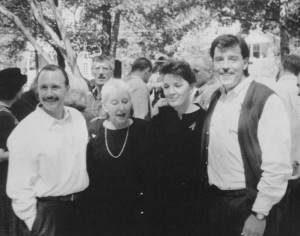Our Debt of Gratitude to Rick Porter
Our Debt of Gratitude to Rick Porter
By Jack White, VHCA President
 A couple of weeks ago we reported in this space the death of longtime VaHi resident and activist Rick Porter. (A link to his obituary in the AJC may be accessed here. In the photo below, Rick is on the far right.)
A couple of weeks ago we reported in this space the death of longtime VaHi resident and activist Rick Porter. (A link to his obituary in the AJC may be accessed here. In the photo below, Rick is on the far right.)
Rick’s mark on this neighborhood is quite significant, but –as is often the case in dynamic and evolving communities – easy to miss.
Virginia-Highland – the community and the name – are defined in modern times by resistance to the efforts of the Georgia Highway Department (now GDoT) to build a multi-lane divided highway from the Atlanta Medical Center on Boulevard to I-85 near Cheshire Bridge. This monstrosity would have allowed northeast-bound commuters to bypass the Grady curve and allegedly reduced interstate traffic volumes downtown (at least for a little while; even GDoT knows better now.) Massive resistance from this and adjacent communities all along the route stopped the road; the coups-de-grace (there were actually several) were supplied by (then) Governor Jimmy Carter and Mayor Maynard Jackson in the early 1970’s.
In the process, the state had acquired quite a few houses, many of which it had immediately demolished, ignoring pleas to await the end of the political discussion. When the road battle was won, many empty lots – including those near Inman School, whose parking lot would have been eradicated by a cloverleaf highway exit on Virginia – sat empty. State law prescribed several next steps, including offering the parcels back to the original owners.
From Lola Carlisle and Karri-Hobson Pape’s 2011 book Virginia-Highland (Note: I was involved in some of the book’s editing):
“Long after the I-485 battle had been won, vacant lots and the foundations of a few homes remained along Virginia Avenue. Years of discussions about what to do with the land ended with an agreement that a park would be built … named after John Howell, a gay rights activist and president of VHCA who died in 1988 from HIV complications. By this point, Virginia-Highland had a significant gay population. The park became one of the first in the country with an HIV component, creating an empathetic face associated with the tragic disease.”
Rick Porter (alongside his longtime partner, Jerry Bright) led the John Howell Park Project, which selected the landscape architect (Peter Frawley, still our LA) and oversaw the entire design, management, and construction process of John Howell Park. The city acquired the land and provided infrastructure support – both real contributions – but this was an era of downsizing in the budget and staff of Atlanta’s Park Department. The fundraising challenges were considerable and required a decade of sustained and innovative efforts, from both obvious sources like VHCA and innovative ones like the sale of commemorative bricks.
It’s easy after the fact to take certain outcomes for granted, particularity when they are successful and institutionalized. As difficult as it is imagine VaHi without John Howell Park, its creation was in no way inevitable. We all owe a huge debt to the determination and persistence of all those who conceived, organized, designed, and built it – Rick and Jerry, the late Tinka Green, Swan McKnight, Josephine Gross, and many others.
There will be a public memorial service for Rick at – quite appropriately – John Howell Park this Saturday, June 20th, at 2 PM.